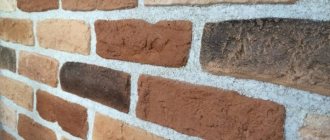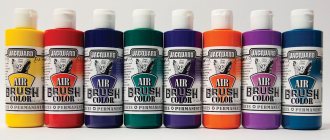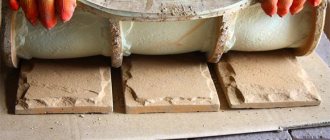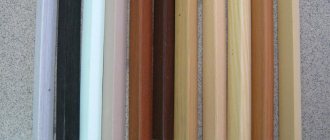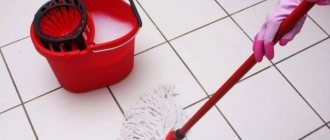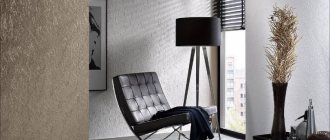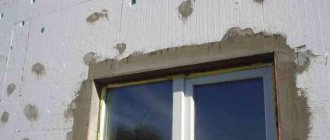There are a large variety of finishing materials on the construction market. Gypsum tiles stand out from everyone else for their practicality and affordability. Gypsum is used to make tiles. You can make gypsum tiles yourself, which also plays a big role in its choice as a finishing material. Decorative tiles do not contain toxins hazardous to health, they are fire-resistant and sound-proof. Finishing a room with tiles is easy to install, the room becomes fashionable and interesting in design.
Gypsum stone tiles are covered with varnish. For long-term use of the tiles, they should be covered with a protective layer. Gypsum tile varnish is best suited for these purposes.
Advantages of gypsum
Various building mixtures are made based on gypsum, both for interior and exterior use. Dry gypsum is added to many putties, plasters and glues as an excellent binding component. This material is added to many finishing and building materials because it has the following advantages:
- external attractiveness;
- low weight, which is combined with high strength;
- creates effective insulation of heat and noise;
- it can be used to make attractive, unique products for interior and exterior decoration;
- environmentally friendly and safe material for human health;
- fungi and mold do not settle on it;
- is a vapor-permeable, breathable material;
- very easy to process, it can be applied to any type of surface;
- With the help of accessible, extraordinary tools, you can easily change the shape of gypsum products.
Improving the performance of gypsum finishes
Manufacturers of alabaster cladding most often offer consumers products that have already undergone a process of improving characteristics and are varnished. The price of such material is higher due to the cost of additional processing. Knowing the optimization technology, you can purchase gypsum cladding without protective treatment, for example, the popular hand-made Monte Alba decorative tiles, and independently improve the properties of the material, and then varnish it. Let's consider what the pre-treatment of gypsum products is before applying varnish, types of varnish compositions and methods of their use.
Impregnation of gypsum tiles with hydrophobic agents
To neutralize the hygroscopicity of gypsum products, they are hydrophobized, which consists of impregnation with water-repellent compounds (hydrophobizers) based on organosilicon polymers. Due to the deep (up to 20 mm) penetration of water repellents into gypsum without the formation of a film, porosity is reduced, but the vapor permeability of the products is maintained, the degree of hygroscopicity and the susceptibility of tiles to mold are reduced.
Impregnation allows you to preserve the attractive appearance of stone and decorative stone tiles for a long time
Water repellents are offered by manufacturers in the form of ready-to-use solutions, as well as concentrated formulations that require dilution. The method of use is indicated on the packaging of the mixture.
The general requirement for the use of hydrophobic compounds is that they be applied to completely dry gypsum tiles that are free of dust. Gypsum products are processed on all sides in two layers until saturated, without waiting for drying. This processing method reliably isolates the cladding not only from the humidity of the outside air, but also from the moisture of the base material. For application, depending on the area of the surface to be treated, a brush or roller is used.
The treatment should be carried out wearing protective glasses and gloves, avoiding contact of the composition with exposed skin. Contamination of adjacent glass and metal parts with a water-repellent agent must be promptly eliminated, as the composition hardens quickly.
Examples of well-proven hydrophobic compounds include:
- water-repellent silicone composition White Hill;
- silicone impregnation “Optimist C405 – Natural stone”;
- a range of Tiprom water repellents.
Silicone waterproofing impregnation – Natural Stone
Varnishing the plaster finish
After hydrophobization of the alabaster tiles, the base is faced by laying gypsum products on an adhesive mixture selected in accordance with the type of wall surface. A day after installation is completed, they begin to decorate the finish with paints.
Types of varnishes and their application
To improve the performance characteristics of gypsum tiles, they should be varnished. The following products are considered the most popular on the market and in construction stores:
- oil-based varnishes;
- yacht varnish for gypsum surface;
- protective acrylic coating.
Oil based varnish
The composition of oily varnishes includes a solution of artificial resins and a collection of plant herbs. The substance is brought to an oily consistency and combined with additional materials, which as a whole form a varnish. Due to its texture, the coating forms a thin film on the surface, which, after complete drying, protects the gypsum tile from physical and mechanical damage.
Oil varnishes can be transparent (colorless) and are also available in a variety of shades. Therefore, when purchasing, compare the color of the original material and its future coating. To give the surface different effects, you can purchase glossy or matte varnish. It should be noted that if you varnish (even colorless) a plaster surface, it may become slightly darker than it was originally.
When covering a wall decorated to look like stone, try to protect your body and face from getting paint and varnish. Wear protective clothing, gloves, goggles and a respirator, as the composition has a specific pungent odor.
On video: varnish for stone.
Acrylic composition
When purchasing varnish for gypsum tiles, most builders want to get a material that will combine “two in one” characteristics. That is, initially it is a protective coating, and only then performs a decorative function.
All desired requirements will be met if you cover the tiles with acrylic varnish. In construction stores or on the market you can purchase ready-to-use material, which, when applied to the surface, forms a durable thin film.
Acrylic varnish is a “protective shield” for artificial stone. It is moisture resistant, reflects UV rays, and is resistant to various detergent compositions and temperature changes. The material has no toxic odor, dries quickly, and if excess needs to be removed, this can be done using a special solvent. If the acrylic varnish is too thick in consistency, it can be diluted with plain water.
Acrylic coating is divided into three types:
If you use matte acrylic varnish to cover the plaster, the imitation of rough stone will be preserved down to the smallest touch. After application, the composition penetrates into all existing cracks and recesses, and as it dries it takes on a transparent matte texture.
Semi-matte plaster varnish has similar characteristics to the previous material. The coating has only one drawback - after drying, you can notice a light light coating on the finish. Of course, if you choose a varnish that matches the tone of the tile, this effect can be avoided, but colorless compositions can present an unwanted surprise.
When choosing a glossy finish, keep in mind that in a brightly lit room the surface will be very shiny. Consequently, the interior decoration will be distorted due to glare.
If, according to the designer’s plan, the gypsum tile will be painted with water-based paint, then for better adhesion of the material to the surface, add acrylic varnish to the solution. The paint should be applied with two salts, and after complete drying, open with one layer of varnish.
Yacht varnish
The most durable material for treating gypsum surfaces is yacht varnish. Based on the name, you can guess that this material is used to cover wooden surfaces on yachts. Its composition will give gypsum tiles 100% waterproofness.
Unusual coloring of a plaster product
There are ways to paint plaster with your own hands, which allow you to achieve an interesting look for the surface, including aging.
Under old marble
- When making it yourself, the stone is thoroughly dried; the temperature should not exceed 55 degrees at the last stage of drying. The purchased product is aged for 48 hours in a warm room.
- Next, heat the drying oil. You must be careful and wear gloves when working.
- A flute brush is used for application. The surface is impregnated in two layers, all areas are treated with special care to avoid gaps.
- Over time, the elements will take on a look reminiscent of old marble.
In addition, such impregnation reduces the hygroscopicity of gypsum.
Antique gypsum tiles, painted with drying oil
Under terracotta
The technology is almost identical to the previous version, but the coating composition is shellac varnish and rosin, which are diluted in industrial alcohol.
After a certain period of time after applying the composition, the surface becomes similar to terracotta.
A mixture of shellac varnish and rosin produces brown plaster.
Creating a bronze sheen
The technology requires the availability of the necessary ingredients and the following steps:
- Plaster figures are well soaked in drying oil and laid to dry for 8–10 hours.
- Bronze powder is prepared, diluted in varnish. Products are treated with this composition in two layers.
- The material dries well.
- A mixture of silver nitrate, acetic acid and water is prepared. Proportions: 10 g of silver, 100 g of vinegar and 300 g of clean water. If required, pigment is added.
- The product is coated with a thin layer of bronze powder and treated with a solution on top. Oxidation occurs.
- The surface is wiped well with a piece of velvet.
The process of painting gypsum stone dark brown with a bronze tint
On a note! If it is necessary to enhance the effect, then the gypsum is additionally treated with a solution of wax in turpentine until the material stops absorbing the mixture. This coating can be washed.
Using stain
Stain is used quite often. It can be applied well with a spray gun, but the best results are obtained when completely immersed. To do this, the composition is slightly heated, the parts are dipped for a short time (5 to 10 seconds) and immediately sent to dry. If required, the fragments are pre-wiped.
Decor options
Gypsum stone can be used to create an imitation of a brick wall in the interior. With the help of such tiles you can create the effect of both red and white brick, which opens up enormous possibilities when arranging modern interiors. When using certain types of dyes, you can achieve the effect of an antique finish. If you dry the tiles enough and then cover them with drying oil, they will begin to look like marble. Gypsum stone is used to cover the walls either completely or partially. It is also used for finishing individual areas: doors, windows, passages, etc.
Gypsum brick in the interior
Impregnation of gypsum tiles
After laying the gypsum tiles and finishing the work with the seams, the tiles should be treated with a special product before applying varnish. Hydrophobization is the treatment of decorative tiles with a water-repellent agent that contains an organosilicon polymer.
When the product penetrates inside the tile (2cm), the porosity of the tile decreases, while maintaining vapor permeability. A water repellent also reduces the appearance of mold.
This solution is supplied to the construction market in finished form. It can also be a concentrate that must be diluted before use.
Water-repellent impregnation for gypsum tiles
You should work with this solution wearing glasses and gloves. The product hardens quickly, so drops of it from the surface can be immediately removed with a damp or flexible cloth. High-quality solutions for decorative tiles imitating brick and imitating stone for interior decoration:
- Organosilicon solutions that are water-repellent White Hill.
- Solution with silicone "Optimist S405".
Solution with silicone “Optimist S405” - Tiprom has several solutions with different functionality.
Return to contents

